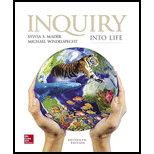
Inquiry into Life
15th Edition
ISBN: 9781259426162
Author: Sylvia S. Mader Dr., Michael Windelspecht
Publisher: McGraw-Hill Education
expand_more
expand_more
format_list_bulleted
Textbook Question
Chapter 22, Problem S21.3BYB
Section 21.2 and 21.3 Where does fertilization usually occur, and what hormonal changes happen after fertilization?
Expert Solution & Answer
Want to see the full answer?
Check out a sample textbook solution
Students have asked these similar questions
What is the difference between Uniporters, Symporters and Antiporters? Which of these are examples of active transport?
What are coupled transporters?
What are “domains” and how do they aid in protein function?
Chapter 22 Solutions
Inquiry into Life
Ch. 22.1 - Identify the major structures of a sperm cell and...Ch. 22.1 - Describe the steps involved in fertilization.Ch. 22.1 - Describe the cellular, tissue, and organ stages of...Ch. 22.1 - Outline the steps of fertilization, beginning with...Ch. 22.1 - Describe two ways that an oocyte avoids...Ch. 22.1 - Compare and construct the cellular and tissue...Ch. 22.1 - Identify the organ system that are formed from...Ch. 22.1 - Only one sperm enters an egg because Sperm have an...Ch. 22.1 - The fusion of a sperm and then it will initially...Ch. 22.1 - Which primary germ layer is not correctly matched...
Ch. 22.2 - Explain how cellular differentiation and...Ch. 22.2 - Explain how cytoplasmic segregation and induction...Ch. 22.2 - Describe how morphogen genes, homeotic genes and...Ch. 22.2 - Describe two process that are associated with...Ch. 22.2 - Define the term “morphogen”.Ch. 22.2 - Explain the function of the homeobox sequence in a...Ch. 22.2 - Which process is responsible for the shape and...Ch. 22.2 - The ability of one embryonic tissue to the...Ch. 22.2 - The Identity of each segment of a development...Ch. 22.3 - Identify the extraembryonic membranes and provide...Ch. 22.3 - Summarize in chronological order, the major events...Ch. 22.3 - Describe the flow of blood in a fetus and explain...Ch. 22.3 - Prob. 1CYPCh. 22.3 - Summarize the major events by month during fetal...Ch. 22.3 - Describe the path of blood flow in the fetus...Ch. 22.3 - Explain the function of the placenta.Ch. 22.3 - Prob. 7ACh. 22.3 - Prob. 8ACh. 22.3 - Prob. 9ACh. 22.4 - Describe changes that occur in Indian psychology...Ch. 22.4 - Outline the stages of birth.Ch. 22.4 - Summarize the advantages of breast-feedingCh. 22.4 - Prob. 1QTCCh. 22.4 - Describe the psychological changes that occur in a...Ch. 22.4 - Identify the stage of parturition in which the...Ch. 22.4 - Define colostrum, and least three advantage of...Ch. 22.4 - Prob. 10ACh. 22.4 - Which of the following is increased in the mother...Ch. 22.5 - Describe the factors that contribute to aging.Ch. 22.5 - Discuss the effects of aging on various body...Ch. 22.5 - What is the rule of the hippocampus, and how does...Ch. 22.5 - How might anti-inflammatory drugs slow the...Ch. 22.5 - Explain how telomeres influence cellular aging.Ch. 22.5 - Summarize how that may contribute to aging.Ch. 22.5 - Summarize the diseases that are associated with...Ch. 22.5 - Prob. 12ACh. 22.5 - Prob. 13ACh. 22 - Prob. S5.4BYBCh. 22 - Figure 21.3 and 21.7 What are the difference...Ch. 22 - Section 21.2 and 21.3 Where does fertilization...Ch. 22 - Prob. 1CSCh. 22 - Prob. 2CSCh. 22 - Mitochondria contain their own genetic material....Ch. 22 - Prob. 2TCCh. 22 - 3. Variety of fertility tests are available for...
Knowledge Booster
Learn more about
Need a deep-dive on the concept behind this application? Look no further. Learn more about this topic, biology and related others by exploring similar questions and additional content below.Similar questions
- What are intrinsically disordered proteins, and how might they be useful for a living system?arrow_forwardWhat are Amyloid Fibrils? What biological functions are these known to perform?arrow_forwardHow do histamine and prostaglandins help in the mobilization of leukocytes to an injury site? What are chemotactic factors? How do they affect inflammation process?arrow_forward
- Compare and contrast neutrophils and macrophages. Describe two ways they are different and two ways they are similar.arrow_forwardDescribe the effects of three cytokines (not involved in the initial inflammation response). What cells release them?arrow_forwardDescribe activation of helper T cells or cytotoxic T cellsarrow_forward
- Compare and contrast MHC 1 and MHC 2. Describe two way they are different and two ways they similar including how they are used in antigen presentation.arrow_forwardDescribe two antimicrobial properties of the skin.arrow_forwardDescribe how the inflammation response starts including the sentinel cells and the chemicals involved. How do pathogens trigger the response particularly in the skin?arrow_forward
- How does complement promote the immune response? Describe three waysarrow_forwardWhich of the following is not a possible mechanism for autoimmunity? Select one: A. Abnormal expression of MHC II molecules in non-antigen-presenting cells B. Activation of polyclonal B cells C. Polymorphism of HLA alleles D. Molecular mimicry E. Release of sequestered antigensarrow_forwardWRITTEN WORK 3: NON-MENDELIAN GENETICS Part A: Complete the Punnett square and calculate for the probability of genotype and phenotype. i i Genotype: Phenotype: 08:55arrow_forward
arrow_back_ios
SEE MORE QUESTIONS
arrow_forward_ios
Recommended textbooks for you
 Human Physiology: From Cells to Systems (MindTap ...BiologyISBN:9781285866932Author:Lauralee SherwoodPublisher:Cengage Learning
Human Physiology: From Cells to Systems (MindTap ...BiologyISBN:9781285866932Author:Lauralee SherwoodPublisher:Cengage Learning

Human Physiology: From Cells to Systems (MindTap ...
Biology
ISBN:9781285866932
Author:Lauralee Sherwood
Publisher:Cengage Learning
The Human Reproductive System; Author: Professor Dave Explains;https://www.youtube.com/watch?v=TucxiIB76bo;License: Standard YouTube License, CC-BY